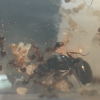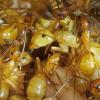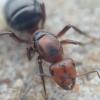- Formiculture.com
- Forums
- Gallery
- Members
- Member Map
- Chat

Formica Subsericea
Started By
Amazant
, Aug 12 2019 10:55 AM
22 replies to this topic
#1
 Offline
-
Posted August 12 2019 - 10:55 AM
Offline
-
Posted August 12 2019 - 10:55 AM
My founding Formica subsericea queens had eggs 3 days after capture then in about a week had huge larvae which was when I checked on them 2 days ago and then last night the larvae became a pupae and this morning I saw another pupae, and right now she has around 5 large larvae and 5 small larvae. I’ve only had her for around 12 days and I read about how that’s how long it usually takes them to even get to the larval stage. Has anyone else experienced this amount of fast growth?
Colonies: Formica pallidefulva, Lasius neoniger, Camponotus decipiens, Camponotus sp, Camponotus Vicinus, Crematogaster Sp
#2
 Offline
-
Posted August 12 2019 - 11:41 AM
Offline
-
Posted August 12 2019 - 11:41 AM
Here is a picture three days after capture

Here is a picture from today


Here is a picture from today

Edited by Amazant, August 12 2019 - 2:50 PM.
Colonies: Formica pallidefulva, Lasius neoniger, Camponotus decipiens, Camponotus sp, Camponotus Vicinus, Crematogaster Sp
#3
 Offline
-
Posted August 13 2019 - 4:58 AM
Offline
-
Posted August 13 2019 - 4:58 AM
Great work! Sounds like an all-star queen you got.
- Amazant likes this
"The ants are a people not strong, yet they prepare their meat in the summer." Prov. 30:25
Keep ordinary ants in extraordinary ways.
Keep ordinary ants in extraordinary ways.
#4
 Offline
-
Posted August 13 2019 - 5:48 AM
Offline
-
Posted August 13 2019 - 5:48 AM
Today the queen had another 1 or 2 pupae and the oldest pupae is starting to get a little dark, does that mean it will eclose soon or dying?
- ANTdrew and Da_NewAntOnTheBlock like this
Colonies: Formica pallidefulva, Lasius neoniger, Camponotus decipiens, Camponotus sp, Camponotus Vicinus, Crematogaster Sp
#5
 Offline
-
Posted August 13 2019 - 7:41 AM
Offline
-
Posted August 13 2019 - 7:41 AM
They usually darken before eclosing. What temperature you keeping this girl at? your queen is ahead of mine and I've had mine like 10 days longer. Whatever your doing keep it up!! ![]()
![]()
Billy
Currently keeping:
Camponotus chromaiodes
Camponotus castaneus
Formica subsericea
#6
 Offline
-
Posted August 13 2019 - 9:50 AM
Offline
-
Posted August 13 2019 - 9:50 AM
My room where all my ants are in is usually around the low to mid eighties in the summer because mother rooms air conditioning doesn’t work and like all my founding queens she is in a dressers cabinet. Also Formica Subsericea are formic acid sprayers right?
So keeping them in an acrylic founding nest after they have 10 or 10 workers would be a bad idea? Would a tubs and tubes setup be better for them? And Thank you for the information about the pupae.
So keeping them in an acrylic founding nest after they have 10 or 10 workers would be a bad idea? Would a tubs and tubes setup be better for them? And Thank you for the information about the pupae.
Colonies: Formica pallidefulva, Lasius neoniger, Camponotus decipiens, Camponotus sp, Camponotus Vicinus, Crematogaster Sp
#8
 Offline
-
Posted August 14 2019 - 10:29 AM
Offline
-
Posted August 14 2019 - 10:29 AM
Any setup with some sort of absorbent substrate would work best for them. Personally I would reccomend a formicarium with a natural, absorbent surface, a dirt setup, or a test tube with some substrate for them.
Would you recommend a tubs and tubes setup with sand?
Colonies: Formica pallidefulva, Lasius neoniger, Camponotus decipiens, Camponotus sp, Camponotus Vicinus, Crematogaster Sp
#9
 Offline
-
Posted August 15 2019 - 1:51 PM
Offline
-
Posted August 15 2019 - 1:51 PM
For about two days now she has had 5 pupae and 5 more larvae, I’ll start adding more pictures once she has her first nanitic.
- ANTdrew likes this
Colonies: Formica pallidefulva, Lasius neoniger, Camponotus decipiens, Camponotus sp, Camponotus Vicinus, Crematogaster Sp
#10
 Offline
-
Posted August 17 2019 - 7:09 AM
Offline
-
Posted August 17 2019 - 7:09 AM
Does anyone know why a queen would destroy the silk around a pupae because mine did it with two of hers so now only 4 of her pupae have the silk cocoons. Should I feed her right now because her Gaster seems extremely small or wait until the nanitics come? Thanks for any help.
Colonies: Formica pallidefulva, Lasius neoniger, Camponotus decipiens, Camponotus sp, Camponotus Vicinus, Crematogaster Sp
#11
 Offline
-
Posted August 21 2019 - 6:30 PM
Offline
-
Posted August 21 2019 - 6:30 PM
She has 8 pupae now and a few more larvae and is doing good one of the pupae will probably be a worker in the next few days hopefully tomorrow as the pupae is a very dark brown with some orange and this is one of the ones where she destroyed the silk.
- ANTdrew likes this
Colonies: Formica pallidefulva, Lasius neoniger, Camponotus decipiens, Camponotus sp, Camponotus Vicinus, Crematogaster Sp
#12
 Offline
-
Posted August 26 2019 - 12:41 PM
Offline
-
Posted August 26 2019 - 12:41 PM
HELP!!! Yesterday my Formica queen had 9 pupae and no larvae and one of the pupae was about to eclose, today I checked in and found the worker dead with its body cut in half like the queen was eating a hotdog and it was all dry and there are only 6 live pupae left, what is going on. This happened before with one of her almost exposed pupae is there anything I can do? 
Colonies: Formica pallidefulva, Lasius neoniger, Camponotus decipiens, Camponotus sp, Camponotus Vicinus, Crematogaster Sp
#13
 Offline
-
Posted August 30 2019 - 1:07 PM
Offline
-
Posted August 30 2019 - 1:07 PM
FINALLY


She had four workers but right when I was about to type this I saw them surrounding a cocoon and watched them help it come out and I saw them pull it out and it was awesome to watch so now she has five workers! I think I even saw a few eggs that the workers were carrying hopefully that setback won’t affect the queen but it seems not to have phased her.


She had four workers but right when I was about to type this I saw them surrounding a cocoon and watched them help it come out and I saw them pull it out and it was awesome to watch so now she has five workers! I think I even saw a few eggs that the workers were carrying hopefully that setback won’t affect the queen but it seems not to have phased her.
- ANTdrew likes this
Colonies: Formica pallidefulva, Lasius neoniger, Camponotus decipiens, Camponotus sp, Camponotus Vicinus, Crematogaster Sp
#14
 Offline
-
Posted August 30 2019 - 4:30 PM
Offline
-
Posted August 30 2019 - 4:30 PM
So cool! I’m happy for you.
"The ants are a people not strong, yet they prepare their meat in the summer." Prov. 30:25
Keep ordinary ants in extraordinary ways.
Keep ordinary ants in extraordinary ways.
#15
 Offline
-
Posted August 30 2019 - 9:25 PM
Offline
-
Posted August 30 2019 - 9:25 PM
Thanks, also have you ever kept Formica pallidefluva?
Colonies: Formica pallidefulva, Lasius neoniger, Camponotus decipiens, Camponotus sp, Camponotus Vicinus, Crematogaster Sp
#16
 Offline
-
Posted August 31 2019 - 2:51 AM
Offline
-
Posted August 31 2019 - 2:51 AM
Man, I wish! I can’t say I’ve ever even seen this species.Thanks, also have you ever kept Formica pallidefluva?
"The ants are a people not strong, yet they prepare their meat in the summer." Prov. 30:25
Keep ordinary ants in extraordinary ways.
Keep ordinary ants in extraordinary ways.
#17
 Offline
-
Posted August 31 2019 - 8:18 AM
Offline
-
Posted August 31 2019 - 8:18 AM
What I've noticed for this species of that they develop as larvae and eggs at an exceptional rate but the pupal stage takes a while.
#18
 Offline
-
Posted August 31 2019 - 1:46 PM
Offline
-
Posted August 31 2019 - 1:46 PM
I noticed that too her pupae seemed to take forever compared to every other stage.
Colonies: Formica pallidefulva, Lasius neoniger, Camponotus decipiens, Camponotus sp, Camponotus Vicinus, Crematogaster Sp
#19
 Offline
-
Posted August 31 2019 - 1:47 PM
Offline
-
Posted August 31 2019 - 1:47 PM
Just like Camponotus. ![]()
"God made..... all the creatures that move along the ground according to their kinds. (including ants) And God saw that it was good. Genesis 1:25 NIV version
#20
 Offline
-
Posted September 3 2019 - 6:38 PM
Offline
-
Posted September 3 2019 - 6:38 PM
One worker has been gathering sand and has made a small pile of sand that leads into the tube, this one is the only one that I see forage. The worker or workers usually forage a few minutes every few hours and go back into the tube. Also I saw some small larvae so maybe they will get into their second generation before hibernation.
Colonies: Formica pallidefulva, Lasius neoniger, Camponotus decipiens, Camponotus sp, Camponotus Vicinus, Crematogaster Sp
0 user(s) are reading this topic
0 members, 0 guests, 0 anonymous users

















